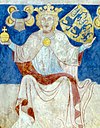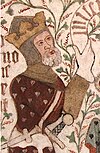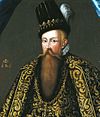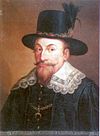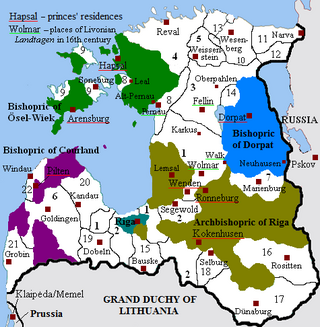
Livonia, known in earlier records as Livland, is a historical region on the eastern shores of the Baltic Sea. It is named after the Livonians, who lived on the shores of present-day Latvia.

Baron Gabriel Gustafsson Oxenstierna was a Swedish statesman.

The Oxenstierna family is a Swedish noble family, originally from Småland in southern Sweden, and is part of the Swedish uradel, the ancient nobility.
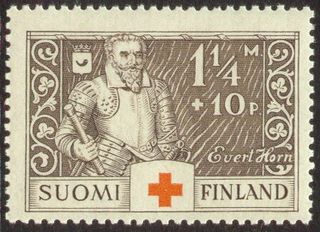
Evert Karlsson Horn af Kanckas was a Swedish field marshal and governor of Narva.

Count Gustav Karlsson Horn af Björneborg was a Swedish nobleman of Finnish descent, military officer, and Governor-General. He was appointed member of the Royal Council in 1625, Field Marshal in 1628, Governor General of Livonia in 1652 and Lord High Constable since 1653. In the Thirty Years' War (1618–1648), he was instrumental as a commander in securing victory at the Battle of Breitenfeld, in 1631. He was High Councillor of the realm in 1625, elevated to the rank of field marshal in 1628, and sometimes commander-in-chief of Swedish forces in Germany during Thirty Years' War. After the war, he served as Governor-General of Livonia 1652, President of War department and Lord High Constable in 1653. In 1651, Queen Christina created him Count of Björneborg.

Swedish Livonia was a dominion of the Swedish Empire from 1629 until 1721. The territory, which constituted the southern part of modern Estonia and the northern part of modern Latvia, represented the conquest of the major part of the Polish-Lithuanian Duchy of Livonia during the 1600–1629 Polish-Swedish War. Parts of Livonia and the city of Riga were under Swedish control as early as 1621 and the situation was formalized in the Truce of Altmark 1629, but the whole territory was not ceded formally until the Treaty of Oliva in 1660. The minority part of the Wenden Voivodeship retained by the Polish–Lithuanian Commonwealth was renamed the Inflanty Voivodeship, which today corresponds to the Latgale region of Latvia.

Field Marshal and Count Jacob Pontusson De la Gardie was a statesman and a soldier of the Swedish Empire, and a Marshal from 1620 onward.

The Swedish nobility has historically been a legally or socially privileged class in Sweden, and part of the so-called frälse. The archaic term for nobility, frälse, also included the clergy, a classification defined by tax exemptions and representation in the diet. Today the nobility does not maintain its former legal privileges although family names, titles and coats of arms are still protected. The Swedish nobility consists of both "introduced" and "unintroduced" nobility, where the latter has not been formally "introduced" at the House of Nobility (Riddarhuset). The House of Nobility still maintains a fee for male members over the age of 18 for upkeep on pertinent buildings in Stockholm.
Nyland and Tavastehus County was a county of the Swedish Empire in Finland from 1634 to 1809.

Swedish Ingria was a dominion of the Swedish Empire from 1583 to 1595 and then again from 1617 to 1721 in what is now the territory of Russia. At the latter date, it was ceded to the Russian Empire in the Treaty of Nystad, at the end of the Great Northern War between the two empires.

The Duchy of Estonia, also known as Swedish Estonia, was a dominion of the Swedish Empire from 1561 until 1721 during the time that most or all of Estonia was under Swedish rule. The territory was eventually ceded to Russia in the Treaty of Nystad, following its capitulation during a plague outbreak in the Great Northern War.
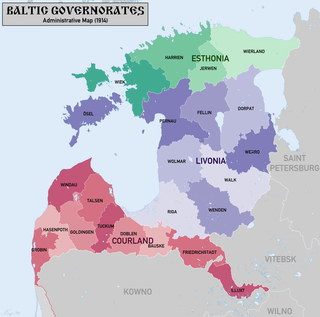
The Baltic Governorates, originally the Ostsee Governorates, was a collective name for the administrative units of the Russian Empire set up in the territories of Swedish Estonia, Swedish Livonia (1721) and, afterwards, of the Duchy of Courland and Semigallia (1795).

The Livonian War (1558–1583) concerned control of Old Livonia. The Tsardom of Russia faced a varying coalition of the Dano-Norwegian Realm, the Kingdom of Sweden, and the Union of the Grand Duchy of Lithuania and the Kingdom of Poland.

The Duchy of Estonia, also known as Danish Estonia, was a direct dominion of the King of Denmark from 1219 until 1346 when it was sold to the Teutonic Order and became part of the Ordensstaat.
The creation and granting of counties and baronies in Finland began with the coronation of King Eric XIV in 1561 and continued through Great Reductions in the latter half of the 17th century.
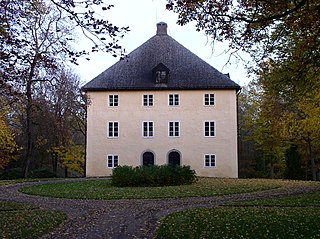
Henrik Klasson Horn , was a Swedish military officer and Governor-General of Finland. He was an ancestor of the noble Swedish family, Horn af Kanckas.

Estonia under Swedish rule signifies the period of time between 1561 and 1710, when present-day Estonia was under the rule of the Swedish Empire. In the wake of the breakup of the State of the Teutonic Order, the Baltic German local nobility in the areas of Harrien (Harjumaa) and Wierland (Virumaa), as well as the city of Reval (Tallinn) in June 1561 asked for and were granted protection by the Swedish king Eric XIV, leading to Swedish involvement in the Livonian War. At the conclusion of hostilities in 1583, Sweden was in control of the northern parts of modern Estonia and Dagö ; the Duchy of Estonia was created from this territory. Following renewed wars between Poland and Sweden, the southern parts of present-day Estonia were incorporated into Sweden by the Treaty of Altmark in 1629. Sweden also conquered the island of Ösel (Saaremaa) from Denmark, and were thus in control of all of present-day Estonia.

The Polish–Swedish War (1563–1568), also called the First Polish War (Polish: Wojna polsko-szwedzka was waged primarily in the Baltic during the larger Northern Seven Years' War between Sweden and the Polish–Lithuanian union, the Duchy of Courland, parts of the Livonian nobility, and Estonian rebels from 1563 to 1568. The war ultimately ended when John III became the King of Sweden, resulting in a Swedish victory.


